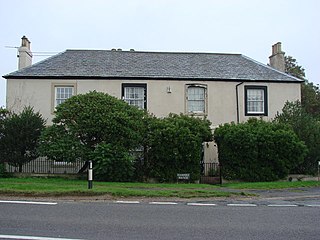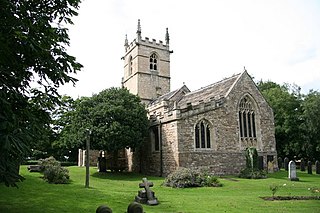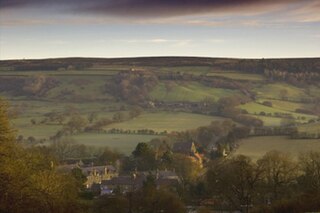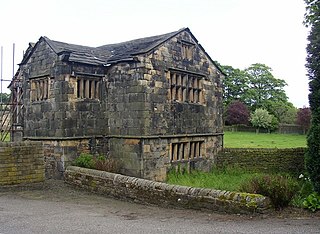
Hampole is a small village and civil parish in the City of Doncaster in South Yorkshire, England, close to the border with West Yorkshire. Historically part of the West Riding of Yorkshire, the eastern boundary of the parish is marked by the Great North Road, and the parish lies in what was once the Barnsdale Forest. It had a population of 187 in 2001, increasing to 203 at the 2011 Census, which includes the neighbouring village of Skelbrooke. Hampole lies on the A638 between Doncaster and Wakefield.

Richard Rolle was an English hermit, mystic, and religious writer. He is also known as Richard Rolle of Hampole or de Hampole, since at the end of his life he lived near a Cistercian nunnery in Hampole, now in South Yorkshire. In the words of Nicholas Watson, scholarly research has shown that "[d]uring the fifteenth century he was one of the most widely read of English writers, whose works survive in nearly four hundred English ... and at least seventy Continental manuscripts, almost all written between 1390 and 1500."
Sopwell Priory was a Benedictine nunnery founded around 1140 on the site of an ancient hermitage in Sopwell, Hertfordshire, England. After the Dissolution, the priory was torn down and a Tudor manor house constructed in its place.

Arthington Priory was an English monastery which was home to a community of nuns in Arthington, West Yorkshire, founded in the mid-12th century. The priory land is occupied by a residence called "Arthington Hall", which was built around 1585, and little, if anything, remains of the priory. The site of the priory church is possibly now occupied by a farmhouse called The Nunnery. The community was the only one of nuns of the Cluniac congregation in Yorkshire and one of two in England. It was established through a grant by Peter de Arthington.

St James' Church, High Melton is a parish church of the Church of England in High Melton, South Yorkshire, England.
Westwood Priory was a priory of Benedictine nuns founded in 1153, near Droitwich, Worcestershire, England. It was a daughter house of Fontevraud Abbey, seized by the English crown in 1537 during the Dissolution of the monasteries.

Rosedale Abbey is a village in the Ryedale district of North Yorkshire, England. It is approximately 8 miles (13 km) north-west of Pickering, 8 miles south-east of Castleton and within Rosedale, part of the North York Moors National Park.
Nunburnholme Priory was a priory of Benedictine nuns in the East Riding of Yorkshire, England. It was founded during the reign of Henry II of England by an ancestor of Robert de Merlay, lord of Morpeth. Except for its demesne, it possessed only little property in its surroundings. In 1313 the prioress claimed the monastery of Seton in Coupland as a cell of Nunburnholme. In 1521 only five nuns and the prioress lived here, and on 11 August 1536 the house was suppressed. It was valued as the poorest and smallest of the Benedictine nunneries in Yorkshire surviving until then.

Swine Priory was a priory in the village of Swine in the East Riding of Yorkshire, England. The site of the Cistercian nunnery is a Scheduled Monument.
Stixwould Priory was a priory in Lincolnshire, England, a Cistercian nunnery founded by Lucy, countess of Chester, in 1135. The Mappa Mundi describes it as Gilbertine, but modern authors regard it as Premonstratensian. Originally suppressed in 1536, Benedictine nuns from Stainfield were then moved in by the King. In 1537 the nunnery was refounded for Premonstratensian canonesses, before being finally suppressed in 1539.
Keldholme Priory was a Cistercian nunnery in Kirkbymoorside, North Yorkshire, England. It was established by one of the Robert de Stutvilles in either the reign of Henry I or II. Two graves are visible, built into the wall of the modern Priory, a house built on the site of the nunnery. The Priory experienced great upheaval in the early 14th century during a disputed election as to who would be Prioress.

Marrick Priory was a Benedictine nunnery in Richmondshire, North Yorkshire, England, established between 1140 and 1160 by Roger de Aske. The parish Church of the Virgin Mary and St. Andrew and 400 acres of local land also belonged to the priory, which thrived until the 16th century, in spite of the depredations of marauding Scots.
Moxby Priory is the commonly used name of the former Augustinian nunnery of S. John the Apostle in today's parish of Marton-cum-Moxby, North Yorkshire, England.

Nun Appleton Priory was a priory near Appleton Roebuck, North Yorkshire, England. It was founded as a nunnery c. 1150, by Eustace de Merch and his wife. It was dissolved by 1539, when the nuns were receiving pensions.

Kirklees Priory was a Cistercian nunnery whose site is in the present-day Kirklees Park, Clifton near Brighouse, Calderdale, West Yorkshire, England. It was originally in the ancient ecclesiastical parish of Dewsbury. The priory dedicated to the Virgin Mary and St James was founded by Reiner le Fleming, Lord of the manor of Wath upon Dearne, in 1155 during the reign of Henry II.
Agnes of Eltham (1498–1530) was an English woman rumored to have been the illegitimate daughter of Princess Bridget of York. Bridget of York was a nun and the daughter of Edward IV and Elizabeth Woodville.
Margaret Kirkby, was an anchorite of Ravensworth in North Yorkshire, England. She was the principal disciple of the hermit Richard Rolle, and the recipient of much of his writings.
Foulbridge is the site of a manor about 2 miles south of the village of Snainton in North Yorkshire, England. The River Derwent flows nearby. Land in the area formerly belonged to Rievaulx Abbey and Foulbridge Preceptory was located here. In medieval times the manor belonged to the Templars, before John de Dalton took over ownership in 1308.

The Keldholme Priory election dispute occurred in Yorkshire, England, in 1308. After a series of resignations by its prioresses, the establishment was in a state of turmoil, and the Archbishop of York, William Greenfield, appointed one of the nuns to lead the house. His candidate, Emma de Ebor', was deemed unacceptable by many nuns, who undermined her from the start to the extent that she resigned three months later. The archbishop, forced to find another candidate, claimed that he was unable to do so from within the priory and appointed Joan de Pykering from nearby Rosedale Priory. It is likely that Keldholme saw de Pykering as an intruder, and it seems to have reacted against her in much the same way as to her predecessor.











